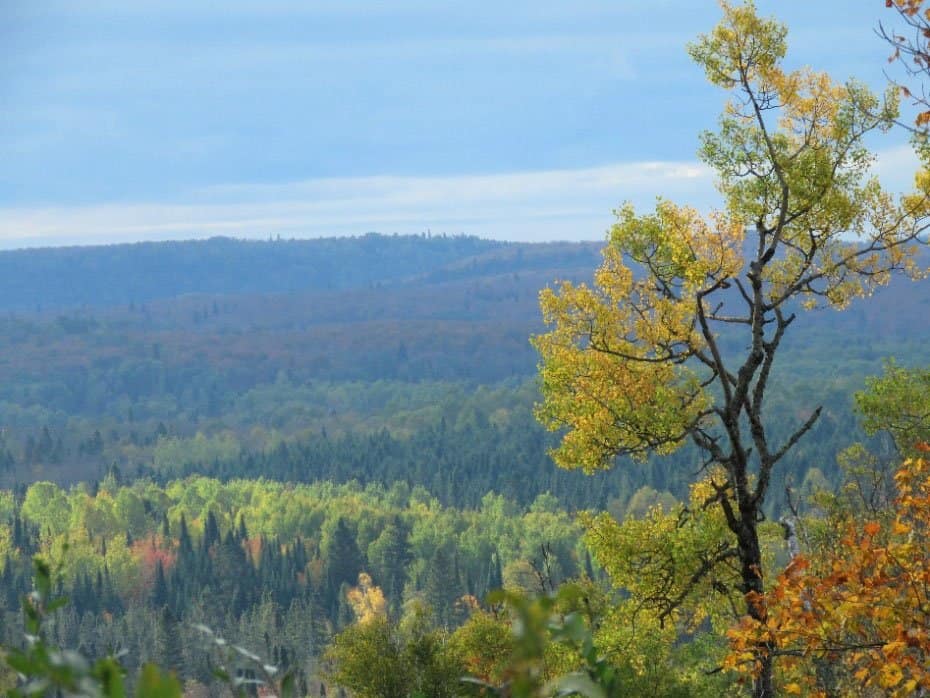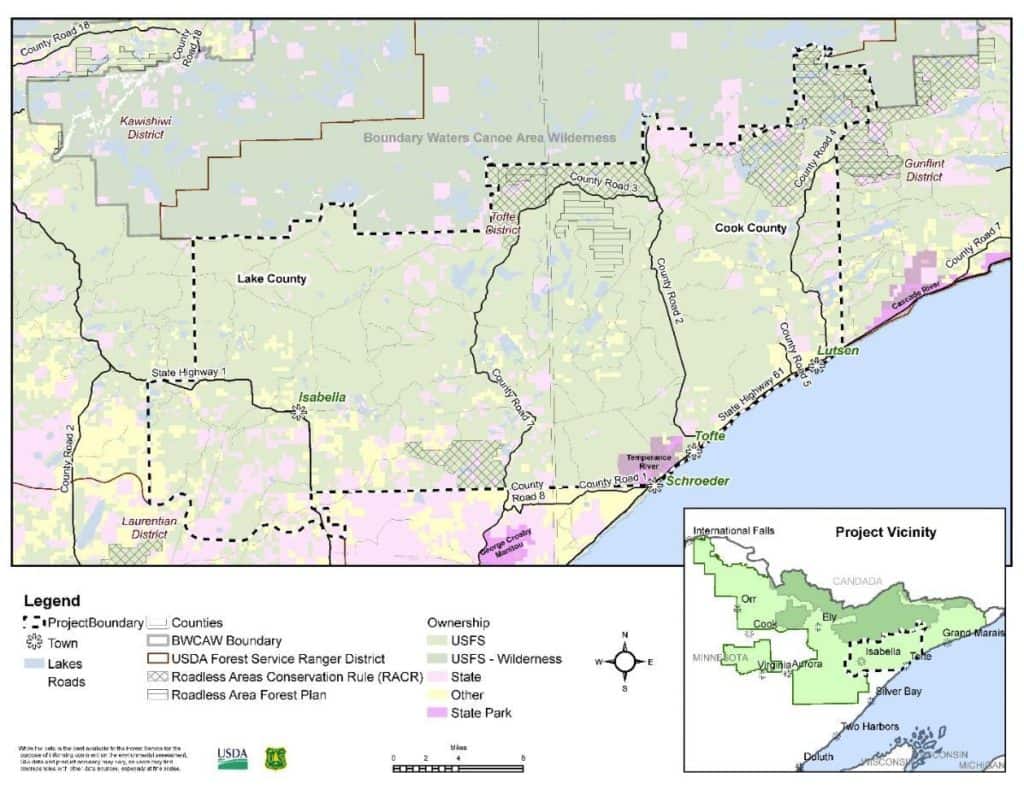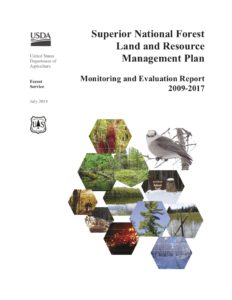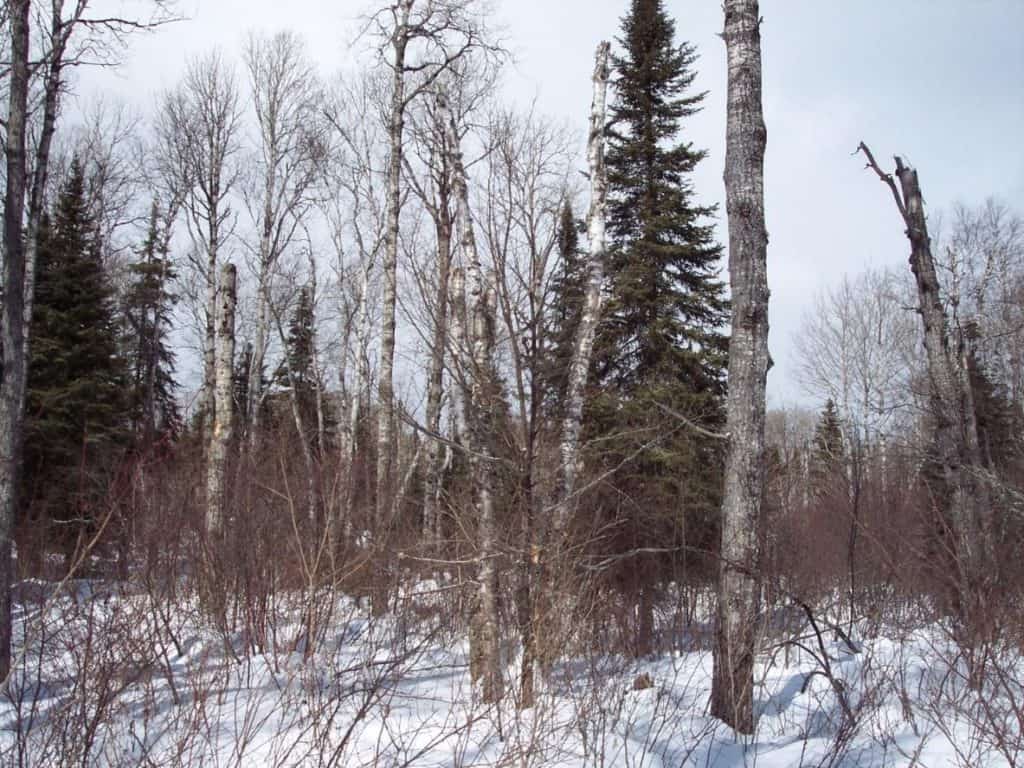
Logging would be capped at 43,035 acres over the 15-year plan period. Another 37,500 acres would be the maximum for prescribed fire. Both are intended to partially mimic natural fire that is essential to forest health in northern Minnesota, as well as providing forest products.
All told, these and other activities would affect more than 100,000 acres of the 482,000-acres Tofte district, on the southern edge of the Boundary Waters Canoe Area Wilderness, including the Sawbill Trail area. The agency has released a Scoping Report for the Tofte Landscape Project, and is inviting public comments by November 3. There will also be two open houses for questions, comments, and to learn more.

Using “conditions based management,” the National Forest is creating a set of management options, guidelines for site selection, treatments designs, and an implementation plan, which includes selecting specific sites and receiving input from partners and the public as the project progresses.
“This new approach will better equip forest managers to respond to rapidly changing forest conditions, increase collaboration with both our partners and the public, and to better manage forest health and resiliency,” Tofte district ranger Ellen Bogardus-Szymaniak wrote in the cover letter.

Report recommends resiliency
In a report on forest conditions released earlier this year, the agency wrote that generally, there are too few areas of young forest, and too much old forest across the 3 million-acre National Forest.
At the same time, diversity of tree types and ages is seen as a critical strategy to adapt to the region’s changing climate, now and in the future. Already, northeast Minnesota is more than two degrees warmer on average than it was 100 years ago, with more warming nearly certain to come.
“Maintaining and increasing the resiliency of forested habitats is becoming increasingly important considerations in forest management,” the Superior National Forest wrote. “Managing for and maintaining biological diversity will become an increasing restoration need into the future.”
The future that the Forest Service envisions is in fact more like its past. Prior to European immigration, the region’s forest experienced more frequent fires, which were often more intense, so they could entirely eliminate stands of trees, creating opportunities for new growth.
The 2017 report recommended management actions to decrease aspen and spruce-fir forest types overall, remove additional aging forest, and increase jack pine and other pine forest types. The speed at which the National Forest ecosystem is changing, and the lengthy process by which management plans are developed, are together making it “outpace” traditional planning, the agency says. They say a lack of staff, time, and money has kept the agency from being able to meet management goals before. This new plan is intended to better work with the resources available.

Right treatment, right place, right time
Previous projects have also shown how forest conditions can change between planning and implementation, meaning significant parts of many plans are never implemented. The specificity required in planning also limited the Forest Service’s ability to to collaborate on treatments with other land managers, and too little time for public engagement, designing treatments, and performing inventory and monitoring.
“A new approach is needed to more rapidly respond to changing conditions and manage for healthy ecosystems,” the Superior National Forest wrote in an online “StoryMap” about the project.
This fresh strategy prioritizes collaboration with partners like other landowners, government agencies, logging companies, and tribal nations, and allowing for more flexibility in completing work.
The idea, the land managers write, is to “put the right treatment on the right acre at the right time.”
The freedom to exercise such flexibility means forest managers may have to diverge from overall forest management guidelines in some specific situations. Such “deviations” could include allowing larger impacts from skidding logs, removing “legacy” stands when insects or disease threaten them, and using machines on thin soils.
Input invited
The scoping report and comment period are the first part of the planning process. After this stage will come the full environmental review. At this point, the Forest Service is particularly interested in the following questions:
- What forest conditions need improving in the project area?
- What types of treatments should we include in the treatment ‘toolbox’ and under what conditions should they be used?
- Are there any project design criteria (landscape filters and operational standards and guidelines) that we should add, change or remove from the project to better achieve the purpose and need, or to avoid and minimize adverse environmental effects to any specific resources or locations?
- How can the implementation plan be designed to best engage other governments, interested organizations and the public in selecting stands and treatments?
There will be two open houses about the project this month:
- 4:00-6:30 p.m., October 16, 2019 – Superior National Forest’s Supervisor’s Office – 8901 Grand Avenue Place, Duluth, Minnesota
- 4:00-6:30 p.m., October 23, 2019 – Tofte Ranger Station – 7355 MN-61, Tofte, Minnesota
Comments can also be submitted through:
- The project StoryMap “Leave a Comment” tab
- Email to comments-eastern-superior-tofte@usda.gov, c/o District Ranger Ellen Bogardus-Szymaniak, Attn: Tofte Landscape Project
- Mail to District Ranger Ellen Bogardus-Szymaniak, Attn: Tofte Landscape Project, PO Box 2159, Tofte, MN 55615;
- Fax to 218-663-8095, Attn: Tofte Landscape Project c/o District Ranger Ellen Bogardus-Szymaniak;
- Hand delivery to the Tofte Ranger Station at 7355 W Hwy 61, Tofte, MN 55615 during normal business hours, Monday to Friday, excluding Holidays (8:00am – 4:30pm).

